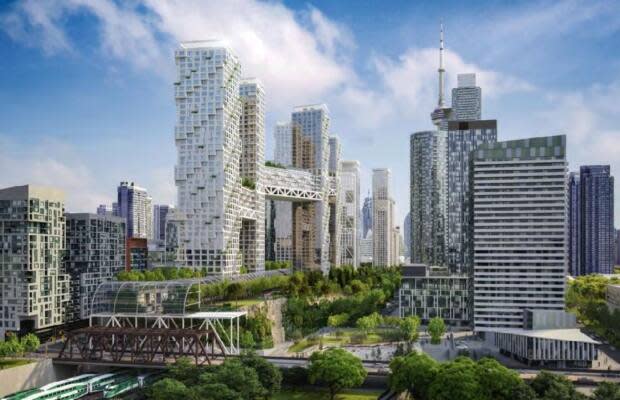With Rail Deck Park probably dead, here's where Toronto could look for other new green spaces

A tribunal ruling that has likely spiked Toronto's plan to build a massive park above a section of railway tracks could inspire the city to think more boldly about adding new green spaces in its downtown core.
"It is a loss," said Shauna Brail, a geographer and urban planner at the University of Toronto.
"While it looks, at least for now, that Rail Deck Park is not going to go ahead, I think we have to look on the positive side and imagine what else we might be able to do as a result."
The ruling, released Wednesday by the Local Planning Appeals Tribunal (LPAT), dealt a potentially fatal blow to Mayor John Tory's years-long plan to build a new 21-acre park above the railway tracks between Blue Jays Way and Bathurst Street..
The provincial tribunal sided with a pair of developers with plans to build mixed-use towers instead on the site.
The City of Toronto referred to its proposal as Rail Deck Park. It was envisioned as both a signature tourist attraction in the mould of Chicago's Millennium Park, and a much-needed addition of green space in an area of the city mostly defined by condos of glass and concrete.
A 2018 study found that Toronto has more total park land per person when compared to Chicago and New York, though in Toronto, much less of that space is in the city centre.
"There is known to be a deficit of green space and park space particularly in the downtown core of the city where the population has grown substantially," Brail added.
City to convert surface parking into new developments
While Rail Deck Park is now unlikely to be built, experts say Toronto does have other opportunities to create new green spaces.
Chief among those is the potential conversion of surface-level parking lots, experts say, some of which are still scattered around the city.

"We cannot bear having underutilized land in the city," said Naama Blonder, an architect and urban planner with the firm Smart Density.
"Surface parking would be number one on the definition of what it means to have underutilized land."
To that end, the city released on Thursday a plan to convert a 120-space Green P parking lot on Dennison Avenue, just north of Queen Street West, into a new affordable housing development with an accompanying park and cultural centre.
Coun. Joe Cressy, whose ward includes the planned development at Dennison Avenue and the proposed site of Rail Deck Park, said parking lots will be just one type of site the city will pursue for future development.
"We need to be more bold with acquiring and developing new and innovative parks and public spaces," Cressy told CBC Toronto.
The decision by LPAT, he said, "cannot dampen our resolve to build parks and public spaces."
Brail suggested some portions of streets, cemeteries, golf courses and Exhibition Place are also candidates for conversion into more useful public spaces.

How private development could still benefit the city
While Tory also said he was "deeply disappointed" by the ruling against Rail Deck Park, Blonder says the proposed private development could still prove to be a useful new addition to the core.
Renderings submitted by the developers, PITS Developments Inc. and Craft Acquisitions Corporation, show a 65 per cent planned allotment of "landscaped open space."
Blonder said a site that includes a large portion of green space in addition to affordable homes and units suitable for families would be more beneficial than just a park. Private development could also save tax dollars, she noted.
"We should really focus on how we as the public can bring our input to make this project an amazing contribution to our city," Blonder said.
Craft president Robert Sabato has said the development will be "family-oriented" and include a "generous portion" of affordable units.
Cressy, however, questions if the developer's plans are realistic, especially when considering needs for services like water and sewage, and the possibile engineering challenges of building towers up to 46 storeys high on a deck above active rail tracks.
The city plans to review the decision but has not announced any plans to challenge the ruling.

 Yahoo Movies
Yahoo Movies 